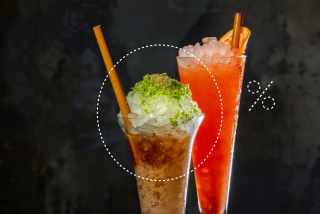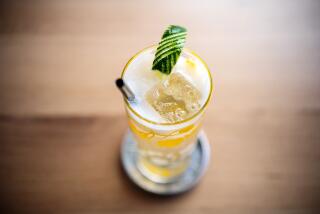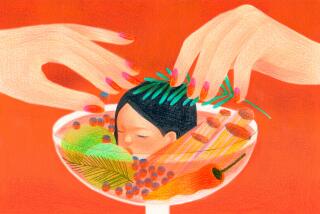Time to clean out, restock your bar
Bored by your bar? As we head into the heart of the holidays, it may be time to take a hard look at what you’re serving to guests in the way of drinks. If you’re in a rut, spirits-wise, now is the occasion to give your bar a holiday makeover.
Before you protest that these gloomy economic doldrums are hardly ideal for lavish spending on pricey single malts and expensively packaged imported vodkas, I’m talking about a few strategic purchases -- no more than your budget will bear -- to restyle your holiday cocktail gatherings.
The time is right, due to the current proliferation of artisanal, small-batch and handmade spirits, as well as high-quality new bottlings from larger producers.
“People are paying more attention to stocking their bar,” says Aidan Demarest, spirits director at the Edison bar and restaurant in downtown L.A. “I’ll pour someone a Rock Hill Farms Bourbon and they’ll say, ‘Oh yeah, I have that at home.’ That’s a big change. Before, most people had a bottle of Johnnie Walker Black and a bottle of Absolut and that was it. Now they have a much smarter drink list at home.”
Updating your bar is a bit like updating your wardrobe. If you’ve got most of the basics covered, you can fill in with a few key, stylish, well-made items that fit your taste and budget.
The first step in a bar makeover is to follow the advice of fashion stylists and closet organizers: Get everything out where you can see it, assess it and get rid of anything you haven’t used in a year. With your bar, this applies to opened bottles, but it’s also a good idea to take a critical eye to unopened bottles. If you and your guests haven’t been interested in drinking them, is that likely to change? (Think re-gifting.)
I acknowledge that for many readers surplus booze is not a problem, but I tend to forget about the stuff at the back of the cabinet, a trait that may run in my family. I recently cleared out the liquor cabinet at my mother’s house in preparation for her move to smaller quarters, and found half-empty bottles of both Galliano and Midori that I suspect date back to each product’s U.S. introduction.
New shelf life
But I digress. The real reason to get rid of the old, opened stuff in your liquor cabinet is that it’s likely to have deteriorated. Leading liquor writer F. Paul Pacult, author of “Kindred Spirits 2,” a collection of spirits reviews and tasting notes, estimates the shelf life of opened bottles of spirits at just three to four months. I’m more liberal (or less discerning) and think up to a year is fine.
With all that bar space opened up, consider some strategic acquisitions that suit the season and your preferences. For example, you might gin up your bar with one of the alluringly aromatic gins that have debuted over the last few years.
At the Edison, Demarest offers an eye-opening gin list with more than 50 entries. For your own bar, you might select the superbly balanced, peppery Leopold’s American Small Batch Gin (about $35; prices are for 750-milliliter bottles unless noted); Anchor Distilling’s Junipero Gin (about $32), boldly spiked with juniper and other botanicals; or the lighter, floral Aviation Gin produced in Portland, Ore. (about $27).
If you’re a vodka person, you’ve probably dabbled in the flavored vodkas, and perhaps have adopted one as your house tipple. But you’re missing a treat if you haven’t focused in on the trio of talented California distillers who make exotic small-batch flavored and infused vodkas -- Miles and Marko Karakasevic of Napa Valley-based Charbay; Jorg Rupf of Hangar One in Alameda; and Melkon Khosrovian of Modern Spirits in Monrovia.
Charbay’s floral, seductive Green Tea Vodka (about $34), Hangar One’s deliciously fruity Fraser River Raspberry Infused Vodka (about $36), and Modern Spirits’ zesty, bittersweet Grapefruit Honey Infused Vodka (about $25 for a half-bottle) are examples with enough flavor interest to stand on their own, served straight up or on the rocks. Store these delicate, refined bottlings in the refrigerator; freezing will damp their aromatics.
This season, bourbon is back -- not that it ever left. At the Wine House in West Los Angeles, spirits buyer Mark Schwarz says that over the last nine months he has nearly doubled his selection of this classic American spirit, thanks to its surging popularity. Bulleit Bourbon Frontier Whiskey is a solid entry at about $26, and at the higher end, Rock Hill Farms Single Barrel Bourbon offers astonishing complexity and creamy smoothness for about $50. A quality, medium-priced bourbon such as Maker’s Mark (about $22) is my preferred liquor to use in eggnog, although in a pinch an aged rum or brandy works fine.
Classic comeback
Got rye? When I started writing about spirits during the 1980s, rye whiskey had virtually died out. America’s historic first whiskey is back and taking its rightful place as a key ingredient in some of the best classic cocktails; the Manhattan, for example, was originally created using rye whiskey. Rye has a distinctive flavor, different from sweeter-smelling, corn-based bourbons, and typically features grainy, citrusy notes with a dry, spicy taste. Try Rittenhouse 10 Year Old Straight Rye Whiskey (about $14), Russell’s Reserve (about $22) or, if you’re getting a bonus this year, Black Maple Hill’s 23-year-old (about $120).
A classic rye Manhattan or a top-shelf Negroni calls for an out-of-the-ordinary sweet vermouth, so put Carpano Antica Formula (about $27 to $29 for a 1-liter bottle) on your shopping list. Aside from the fact that this Italian vermouth is packaged in possibly the coolest vintage-looking bottle ever, Antica Formula is a complex, richly flavored aperitif that’s superb on its own over ice or used as a mixer.
Don’t overlook bitters; the bar staple Angostura has a signature flavor that’s mandatory in a Manhattan, but there’s a brave new world of bitters out there, including an entire line from Fee Bros. (about $4.50 for 4-ounce bottles of flavors such as orange, peach and mint), which can be deployed in a variety of drinks. Also note the tincture concocted by spirits writer Gary Regan called Regans’ Orange Bitters No. 6 (about $6 for a 10-ounce bottle), which adds an ineffable fragrance to a dry gin martini.
After dinner, there are the usual suspects among the digestifs: the añejo rums and tequilas, the aged single malts, the Cognacs, the fine alembic-style brandies from California, and even absinthe, which has made a huge resurgence since its U.S. reintroduction last year.
But this season, I’m suggesting an old favorite that plays to our collective coffee obsession and may be the most sublime hot beverage ever created: Irish coffee, the real thing topped with freshly whipped cream and sweetened with brown sugar, a tip I picked up in Northern Ireland years ago.
Few bars are set up to make this drink properly, but it’s a no-brainer for the home mixologist who can brew a decent cup of joe and whose cholesterol count permits this admitted indulgence. Tullamore Dew (about $24) is a well-mannered, smooth blend that’s luscious in coffee and the only brand among the top three Irish whiskeys still owned by an Irish company. A hint to holiday party hosts: Treat yourself to an Irish coffee after the guests leave. There’s usually leftover coffee sitting around, and a bit o’ the Irish takes the curse off the cleanup, for sure.
More to Read
Sign up for our L.A. Times Plants newsletter
At the start of each month, get a roundup of upcoming plant-related activities and events in Southern California, along with links to tips and articles you may have missed.
You may occasionally receive promotional content from the Los Angeles Times.






